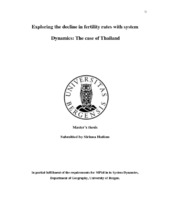Exploring the decline in fertility rates with system dynamics: The case of Thailand
Master thesis
Permanent lenke
https://hdl.handle.net/1956/8407Utgivelsesdato
2014-05-31Metadata
Vis full innførselSamlinger
- Department of Geography [634]
Sammendrag
Since 1950, the changes in fertility behavior in the Thai population have proved to be very interesting. Between the years of 1950 to 1957, the government invoked a pro-natalist policy and created the Married organization where the fertility rate has increased in that period. In 1960, the government concerned about the increasing in fertility rate, which led to the introduction to the National Family Planning Program, under the Ministry of Public Health, which promoted the voluntary use of contraception. Since then the fertility pattern has entered controlled fertility". To date, fertility continues to decline and is currently below replacement level. The changes in fertility rates, and the shifts in government policy, require research into the causes of the factors influencing the total fertility rate (TFR). In this study, a Thai TFR model is constructed by using system dynamics modelling concept", to investigate TFR behavior, including the effects of government policy. This system dynamics model has been examined and analyzed, which leads to the conclusion that the increase in fertility rates in 1950s were caused by the government pro-natalist policy. On the other hand, the later decline in fertility was influenced by the intensity of the support for the government's anti-natalist policy (National Economic and Social Development Plan [NESDP], 1970). Finally, this research provides the policy recommendation, which aims to support child bearing cost. This policy leads couple to perceive the decline in cost, they will then prefer more children. However, the government should also focus on the promotion of population quality, ensure that all births are desirable and safe, mothers and babies are provided with quality services.
